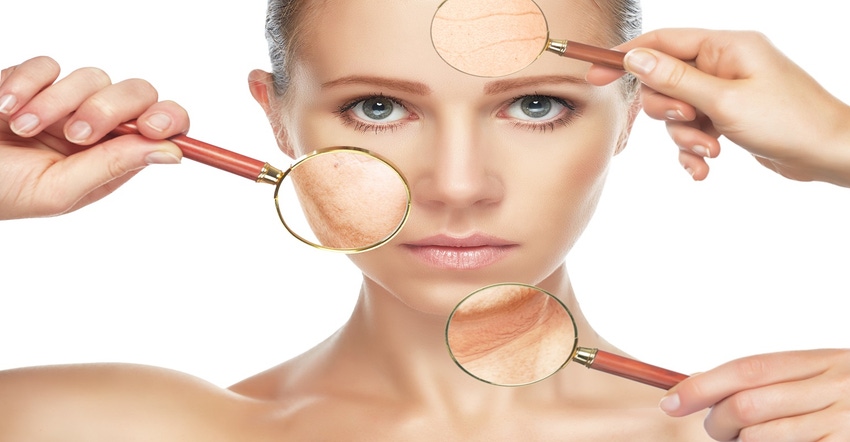Beneath the surface of skin health: Causes and solutions
Registered pharmacist David Foreman examines risks factors for poor skin health and four areas that can affect beauty from within effectively.

While the natural products industry spends most of its efforts on the beauty aspects of skincare, the market for skin conditions also offers a huge opportunity.
Skin disease affects between 30% and 70% of individuals, with at-risk subpopulations subject to even higher rates, according to a 2014 article published in the Journal of Investigative Dermatology. Per Fortune Business Insights, the entire skincare market was valued at over $104 billion in 2022, and it is projected to reach a valuation of $109.7 billion in 2023.
For centuries, people have approached skin health with topical applications, but— physiologically speaking—the best approach is "beauty from within." Why? Skin cells grow from the inside out, not the outside in. Plus, we are now learning that consuming essential nutrients will significantly impact skin health far beyond beauty.
Skin health risk factors
As with all areas of health, certain risk factors contribute to why a person may develop a health challenge. Skincare is not immune to risk factors. Here is a quick list of risk factors for poor skin health:
Hormone
Poor sleep
Sun exposure (ROS)
Pollution (ROS)
Allergies
Diet
Nutrient depletions
Gut-skin axis
Health conditions (diabetes, immune weakness, thyroid problems, bowel disorders)
4 key areas to address for improving skin health
Regarding the above risk factors, four vital areas impact beauty from within effectively, including the reduction of reactive oxygen species (ROS), providing essential nutrients, managing proper skin hydration and the gut-skin axis. Let's look at these four areas and how they can be addressed with clinically substantiated ingredients.
Reactive oxygen species (ROS) (a.k.a. oxidative stress)
Oxidative stress triggers the production of three enzymes that contribute to the degradation of elastin (elastase), hyaluronic acid (hyaluronidase) and collagen (metalloproteases). Oxidative stress will also provoke skin lipid peroxidation and various DNA damage. Whether the body creates the oxidative stress (comes from within) or from an outside source (examples: UV damage and pollution), research has shown oxidative stress leads to protein and DNA damage, abnormal cross-linking of collagen fibers, as well as changes in the physical, structural and physiological properties of the epidermis and dermis. Simply put, ROS contributes to aging skin (i.e. wrinkles, age spots, reduced elasticity and decreased hydration).
Consumption of antioxidants has been well-accepted as the best way to support the neutralization of oxidative stress. Within the dietary supplement arena, a few popular ingredients are linked to being ROS reducers and have science for skin care and reduction of photodamage. Below are several examples:
Astaxanthin
Indian gooseberry
Lycopene
Maritime pine bark (Pycnogenol®)
Red Orange ComplexTM
Turmeric (curcumin)
Key nutrients
Common sense says it’s necessary to provide the proper building materials to create new and healthy skin cells. Since these cells grow from the inside out, consuming essential nutrients can play an important role in skin health.
According to an article from the Linus Pauling Institute affiliated with Oregon State University, several key nutrients are required for skin health and growth, including:
Vitamins – A, C, D and E
Minerals – primarily zinc and selenium, but all essential minerals contribute
Essential fatty acids – both omega-3s and omega-6s
Flavonoids – the list from ROS is a good start
Peptides – multiple sources
Skin hydration
Proper skin hydration begins with water, but science shows several supplements also impact skin hydration.
These products include:
Astaxanthin
Collagen peptides – numerous brands
Ceramides
Essential fatty acids
Hyaluronic acid
Probiotics
Gut-skin axis
The connection between gut and skin health is often called the gut-skin axis. Through complex immune mechanisms, the gut microbiome's influence extends to involve remote organ systems, including the skin. With intentional modulation of the microbiome, probiotics, prebiotics and synbiotics have proven to be beneficial in the prevention and/or treatment of inflammatory skin diseases, including acne vulgaris, atopic dermatitis and psoriasis.
Products to promote the gut-skin axis include:
Probiotics
Prebiotic fibers
Postbiotics
Synbiotics
Do not assume that generically picking one or more of the above gut-skin axis solutions will achieve a positive skin health result. Seek solid research on those with skin-health efficacy.
Bonus area to consider: stress
Chronic stress can induce various skin disorders by activating two mechanisms. First, psychological conditions can generate systemic oxidative stress, leading to the formation of reactive oxygen species. Second, psychological stress can activate the hypothalamic-pituitary-adrenal (HPA) axis at systemic and skin levels and provoke local immune dysregulation, inflammation and vasodilation. Moreover, chronic activation of glucocorticoids can negatively impact collagen I and III, proteoglycans and elastin, which are essential to maintaining skin structure.
Summary
Skin health is not as simple as we may think. Care needs to be taken to combine ingredients with differing mechanisms of action to achieve a solid foundational supplement (or functional food) with efficacy. For one to "hang their hat" on just one ingredient will most likely lead to an ineffective result and decrease consumer confidence that "going natural" works. In addition, selecting only those ingredients with clinical substantiation and using them at their therapeutic dose should be a high-level consideration.
Editor's note: For more information about this topic, watch this on-demand LinkedIn Live presentation of Health Condition Corner: Beauty from within.
David Foreman is a registered pharmacist, author and media personality known to consumers internationally as “The Herbal Pharmacist.” A background in pharmacy and natural medicine puts Foreman in an elite class of health experts who can teach integrative medicine practices. He helps consumers achieve health and vitality through his four pillars of health: diet, exercise, spirituality and supplements. Foreman is a graduate of the University of South Carolina College of Pharmacy, currently serves on the Organic & Natural Health Association’s (O&N) scientific advisory board and is the author of “4 Pillars of Health: Heart Disease.”
About the Author(s)
You May Also Like






.png?width=800&auto=webp&quality=80&disable=upscale)